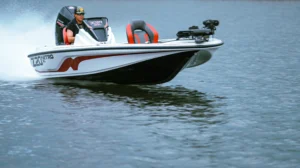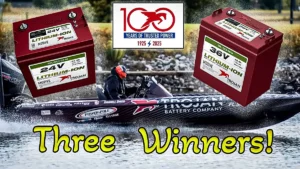The first look at a shallow, eutrophic body of water can be extremely overwhelming. There is so much going on above and below the water’s surface, thanks to the wealth of nutrients supercharging the vegetation. All this growth can create great habitat, but it can be a struggle to unlock a body of water when there is so much going on.
Understanding the different species of plants, how and where in the lake they grow and most importantly, how fish relate to them, is the key. We’ll show you what to look for, how to dissect a eutrophic system, and discuss how most fish relate to these types of common aquatic vegetation species.

FLOATING VEGETATION
Floating vegetation is any plant that has a root system suspended below it. These rely primarily on nutrients in the water to survive, their leaves floating on the surface gathering sunlight and their roots hanging below. This allows these types of plants to move across the body of water with ease. Depending on weather conditions, that could cause the plants to either disperse or concentrate in certain areas. Good examples of this would be watermeal or duckweed, and anglers see them as a blessing or a curse.
Because these plants move so frequently, it’s hard for fish to consistently set up within them. When it does collect on the surface and “mat” up, it can be a haven for many warmwater species, including largemouth and sunfish. It acts as a canopy, shutting out most light which will decrease water temperature and make it an area of refuge during the summer months. Many aquatic invertebrates use floating vegetation, especially many species in the larval stage, making it a great feeding area.
Floating vegetation offers some of the best frog fishing you can find, with some of the most impressive blow ups from big largemouth. Frogs such as a Booyah Pad Crasher or a Spro Bronzeye Frog are perfect for this scenario as you can walk them efficiently through the floating vegetation. Popping frogs can also be very effective if the vegetation is more sparse, which will allow the baits to spit more water. Use a reel with a high gear ratio stuffed with straight braid and a long, stout rod for this application.
My favorite bait to fish around this type of cover is a weightless, fluke-style bait. Plastics such as an original Zoom Super Fluke or a Lunker City Slug-Go rigged on a 3/0 EWG worm hook are my go-to. Fish these on straight braided line, using a long, stout spinning rod and a spinning reel with a large arbor—the wide diameter of the spool will allow it to pick up line quickly, like a fast baitcaster. You want to be able to get that fish in the boat as quickly as possible.

SUBMERGENT VEGETATION
Submergent vegetation, also known as submerged aquatic vegetation, can provide some of the best fishing in the whole lake. These plants are rooted on the bottom and grow vertically towards the surface. Generally, they don’t grow far enough up to reach the surface. But in certain circumstances, with enough nutrients, they can get tall enough to provide a canopy. Perfect examples of these are Eurasian water milfoil, hydrilla and coontail, some of the best aquatic vegetation there is for fish habitat. As the plants grow throughout the season, they create more habitat for feeding, as well as providing young-of-the-year fish a place to grow.
Many submergent plant species have significant edges which act as fish highways. Species like largemouth bass, northern pike and walleye cruise these edges looking for their next meal and often set up as they would on a shoreline. Points, fingers and coves in the weeds are primary examples on where fish would set up in order to ambush their next meal.
When you think of flipping, this is the type of vegetation that comes to mind. Sometimes there are holes in the vegetation, created by rock, wood and or artificial debris on the bottom, that bass and other predatory fish gravitate towards to ambush their prey. Targeting these with a skirted jig or a Texas-rigged creature bait with a pegged weight can pay off in a big way. Jigs such as a Beast Coast Fishing Lil’ Magnum jig paired with a NetBait Paca Chunk trailer are what you want for flipping vegetation like this. The small profile packs a big punch when the jig is falling through the grass, triggering a reaction strike.
A Texas-rigged creature bait with a pegged bullet weight can be beneficial when the vegetation becomes more dense. They move through dense cover better than a jig, and isn’t as likely to snag vegetation. Baits such as a Reaction Innovations Sweet Beaver or a Berkley Powerbait Chigger Craw are some top-rated flipping baits. Braided line on a long, stiff, moderate-action flipping stick is a must for fishing in this kind of slop.
Personally, I like heavy fluorocarbon line for flipping. In many of our northern waters, zebra mussels are abundant and seem to love growing on stands of submergent plants. Fluorocarbon line allows for extreme abrasion resistance and still has the cutting power to get those big fish out of the weeds.

EMERGENT VEGETATION
Emergent vegetation is a large category of plants including cattails, lilies, rushes and phragmites. These are the in-between species that can grow in standing water as well as in moist areas away from water. Generally, they have vast root systems, called rhizomes, that branch out, allowing them to spread out easily. These plants grow in much shallower water than the rest of the other types of vegetation, but also serve as excellent habitat for many species of fish.
Usually, fish sit inside the vegetation waiting to ambush their prey swimming on the outside. And when this vegetation is close to the shoreline, prey could even consist of land animals. Mice, birds and snakes all come into play; which is why large, weedless topwater lures work so well around this type of vegetation. Frogs in a darker color, like a River2Sea Bully Wa Frog, excel at drawing ferocious topwater strikes from bass and pike. Again, heavy artillery such as a flipping stick with straight braided line is key for wrenching those fish out of the cover.
Many species cruise the edges of emergent vegetation looking for a meal. Utilizing bigger baits to pull fish from the heart of the vegetation is crucial. This is where a large spinnerbait or vibrating blade bait shines; something that’s going to put a lot of vibration in the water to turn on predatory fish. My favorite for this scenario would be a Strike King Midnight Special spinnerbait. That large Colorado blade has a large “thump” to it that it drives fish crazy.
Bladed swim jigs such as a Z-Man Jackhammer or a Strike King Thunder Cricket are awesome for this as well. Both create intense vibration that causes anger strikes. A shorter rod in the 6 foot, 8 inch range can be beneficial for this type of fishing. Being able to roll cast to different cuts in the vegetation can be the ticket for getting more bites.
LIFE’S A GARDEN. DIG IT.
Hopefully you all have a better understanding of how to tackle weedy, eutrophic bodies of water. It can be overwhelming at times, but it can be amazing fishing once the code is cracked! Use these tips, and let us know how you made out.












